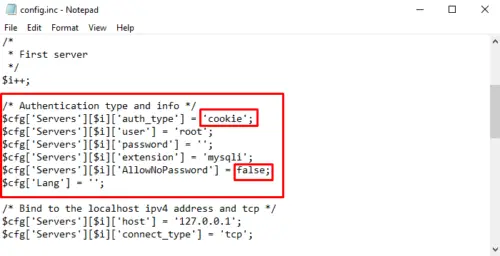

- #CHANGE PASSWORD PHPMYADMIN FOR FREE#
- #CHANGE PASSWORD PHPMYADMIN HOW TO#
- #CHANGE PASSWORD PHPMYADMIN WINDOWS#
If your password has already been set or changed at another time, you will need to use the following command: 1 mysqladmin -user = root -password = OLDpass password "NEWpassword" This command will let you set the password only if you are using the default BLANK password. In order for this command to work correctly, you must have the double quotation marks. This will reset the user named "root" with a new password of "SUPERsecretPASSWORD" (without the quotes). Think of them as part of the correct syntax for the command. If you do not have these double hyphens then the command will not work. Note the double hyphen before the user, these are important. In the command prompt type the following: 1 mysqladmin -user = root password "SUPERsecretPASSWORD"
#CHANGE PASSWORD PHPMYADMIN HOW TO#
How to change the root password for MySQL This will open a black window titled "XAMPP for Windows".

#CHANGE PASSWORD PHPMYADMIN WINDOWS#
Next, launch the specialized Windows command prompt by clicking the "Shell" button on the right hand side. You will know they are running by their names being highlighted in green. Here's How! First, start your MySQL/Apache serverįirst open up your XAMPP control panel and verify that Apache and MySQL are running.

That's not very security conscious of us now is it? The good news is that you can change the root password (aka admin password) for your localhost phpMyAdmin/MySQL account in just a few minutes. One of the things that gets forgot about in a lot of these cases is some basic security practices, like not using the default password.įor almost every XAMPP installation, people tend to keep their default BLANK password. One of the best things about running your own localhost XAMPP web server is being able to do all the testing and projects you want for no charge at all. + Password Managers.It is easy and quick, especially if you are running an XAMPP localhost web server. Network Security, WiFi Security, WiFi Hackers, Firewalls, Wireshark, Secure Networking. In this first example, we’ll see how to insert a new line directly from PHP.Ĭomplete Security Course Become a cyber security specialist. In PHP, there is a pack of functions, starting by mysqli_* that allow you to work with MySQL database. I’ll show you with PHP as it’s the most used language for MySQL, but you can find similar functions in other languages too. You now know almost everything, the only step missing is how to check the used password is correct on sign in. But for my basic table, it’s enough 🙂 PHP You can find the MySQL documentation here if you have any specific thing to handle. Once you have the MySQL Query set for your new users, you can click on “SQL” and paste it directly in PHPMyAdmin. This query will do the same thing for example: INSERT INTO users So, we just add the “MD5()” function to the password in text, and it will insert a line with a MD5 hash.īy the way, the auto_id field is not mandatory, and will be filled automatically even if you don’t set it to “NULL” in the query. In any case, here is an example: INSERT INTO users If you followed the previous method with PHPMyAdmin, you may have seen the MySQL query displayed on your screen. This should be more convenient than PHPMyAdmin to do this automatically. In this part, I’ll show you how to do the same thing directly in MySQL, but also with PHP. Once done, the lines look like this: The password is correctly encrypted in the field Set a MD5 Password in MySQL and/or PHP directly Stay tuned with the latest security news! You'll enjoy receiving the recent articles directly in your inbox every week! I'm in!
#CHANGE PASSWORD PHPMYADMIN FOR FREE#
Hide your IP address and location with a free VPN: Try it for free now, companies are paying for you.ġ500 servers in 120 countries.


 0 kommentar(er)
0 kommentar(er)
